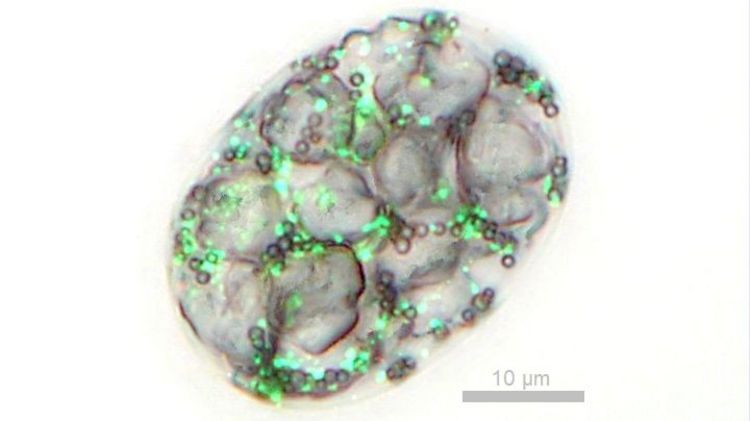Bacteria normally carry their genetic information on a single chromosome and maybe some plasmids. Well known exceptions from this are some giant bacteria like the large sulfur-oxidizing bacterium Thiomargarita namibiensis. Those are known to be polyploid, meaning that they harbor several chromosomes assumed to be identical copies. A team of researchers from the Leibniz Institute of Freshwater Ecology and Inland Fisheries (IGB) in Berlin and the Institute for Chemistry and Biology of the Marine Environment (ICBM) at University of Oldenburg now has analysed the largest freshwater bacterium, Achromatium oxaliferum. This still uncultured sulfur oxidizer thrives at the oxic-anoxic interface of Lake Stechlin sediments. The large cells are visible for the naked eye due to calcite bodies filling major parts of the cell volume. Single cells of Achromatium were found to carry up to 300 DNA spots (Fig. 1). However, single-cell and metagenomic analysis showed that these are not identical copies. Instead, there is a large diversity represented as well in the ribosomal RNA (rRNA) sequences as in various protein-coding genes. Sequence-specific staining of rRNA sequences (using fluorescence in situ hybridization, FISH) showed that different areas of single cells represent different phylotypes and express different proteins. Thus, Achromatium cells – morphologically behaving and dividing like a single cell – carry a genomic diversity typical for a whole population. The ‘bacterial super-organism’ is even more complex than a multicellular organism that carries cells with identical genomes. The evolution of the phenomenon remains to be unraveled. Possibly transposon mutations might have been involved as the cells contain a high number of transposable elements.
Weblinks:



![[Translate to English:]](/f/5/_processed_/3/2/csm_ICBM-Logo-transparent-_91fe1c6774.png)
